40 hour battery?-Philae lander makes historic touchdown on comet 67P | Science | The Guardian
The European Space Agency mission control in Darmstadt, Germany, celebrates as Philae touches down
The signal broke a seven-hour wait of agonising intensity and sparked scenes of jubilation at the European Space Agency’s mission control in Darmstadt. The team in charge of the Rosetta mission achieved what at times seemed an impossible task by landing a robotic spacecraft on a comet for the first time in history.
The moment the tension broke came shortly after 1600 GMT when the Philae called home. “We are there. We are sitting on the surface. Philae is talking to us,” said a jubilant Stephan Ulamec, Philae lander manager at the DLR German space centre. “We are on the comet.”
Andrea Accomazzo, the Rosetta flight operations director, added: “We cannot be happier than we are now.”
But celebrations were tempered by the later discovery that the probe’s two harpoons had not fired to fasten the craft down in the ultra-low gravity. Scientists now think the probe may have bounced after first coming into contact with the surface. Ulamec said: “Maybe today we didn’t just land once, we landed twice.”
The safe, if precarious, touchdown of the lander gives scientists a unique chance to ride onboard a comet and study from the surface what happens as its activity ramps up as it gets closer to the sun. The first images beamed back from the lander’s descent revealed a dramatic landscape of pits and precipices, craters and boulders. However, there have been gaps in its radio link with the orbiting Rosetta mothership.
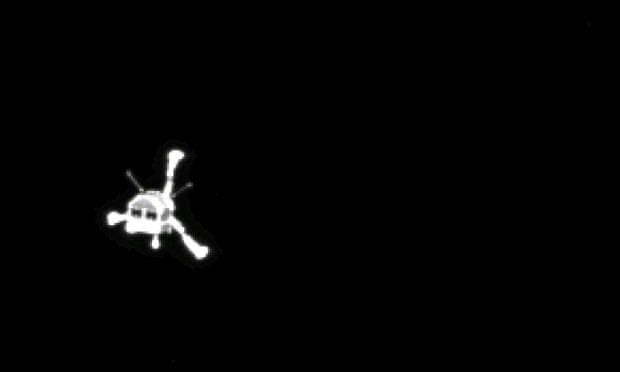 The Philae lander on its way to the comet, photographed by the Rosetta spacecraft.Photograph: AP
The Philae lander on its way to the comet, photographed by the Rosetta spacecraft.Photograph: APThe £1bn ($1.58bn) Rosetta mission aims to unlock the mysteries of comets, made from ancient material that predates the birth of the solar system. In the data Rosetta and Philae collect, researchers hope to learn more of how the solar system formed and how comets carried water and complex organics to the planets, preparing the stage for life on Earth.
Space agencies have sent probes to comets before, but not like this. In 1986, Nasa’s Ice mission flew through the tail of Halley’s comet. In 2005, the agency’s Deep Impact spacecraft fired a massive copper block at comet Temple 1. But none before now has landed.
The feat marks a profound success for the European Space Agency (ESA), which launched the Rosetta spacecraft more than 10 years ago from its Kourou spaceport in French Guiana. Since blasting off in March 2004, Rosetta and its lander Philae have travelled more than 6bn kilometres to catch up with the comet, which orbits the sun at speeds up to 135,000km/h.
“We are the first to do this, and that will stay forever,” said Jean Jacques Dordain, director general of the ESA.
Matt Taylor, a Rosetta project scientist, who had selected an extremely colourful shirt for the event, revealed an impressive – and brave – tattoo of the lander on the comet’s surface.
“Comets are the original source of Earth’s water. That wee lander is now in position, poised to re-write what we know about ourselves,” tweeted Chris Hadfield, the former Canadian astronaut and commander of the International Space Station.
Early data from the lander revealed that it had had a softer landing on comet 67P than expected. But an hour after the landing signal came through, Paolo Ferri, the ESA’s head of mission operations, said that Philae’s twin harpoons, which are intended to secure it in place, had not fired, raising fears about the lander’s stability and chances of clinging on to the comet for long.
Touchdown for the lander played out 510m kilometres from Earth, between the orbits of Mars and Jupiter, on a comet hurtling through space at more than 18km/s. At so vast a distance, even radio signals travelling at the speed of light take nearly half an hour to travel from Earth to the spacecraft, making real-time control of the landing impossible. Instead, the entire descent was precalculated, uploaded and run automatically.
Landing Philae on the comet’s surface was never going to be easy. When ESA managers got their first closeup of the comet in July, its unusual rubber duck shape left some fearing that a safe touchdown was impossible. The shape was not the only problem. The comet’s surface was hostile: hills and spectacular jutting cliffs gave way to cratered plains strewn with boulders. If Philae landed on anything other than even ground it could topple over, leaving it stranded and defunct.
Rosetta spent weeks flying around the comet to create a surface map from which mission controllers could choose a landing site. They faced a trade-off: the site had to be fairly flat and clear of boulders, but with a good view of the whole comet and plenty of sunlight to charge the lander’s batteries. From a shortlist of five potential landing spots, scientists and engineers unanimously voted for a 1 sq km region on the comet’s “head” later named Agilkia.
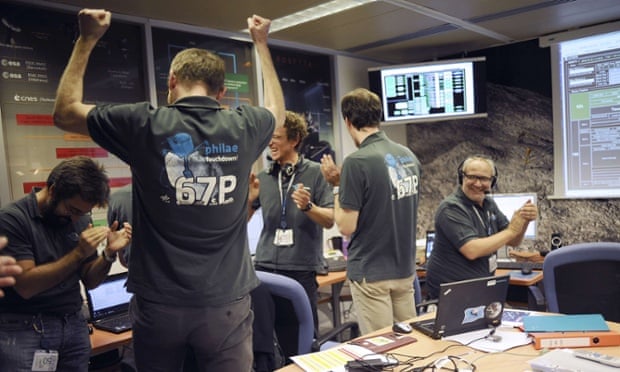 Scientists celebrate at the space centre in Toulouse as they learn that Philae has landed.Photograph: Remy Gabalda/AFP/Getty Images
Scientists celebrate at the space centre in Toulouse as they learn that Philae has landed.Photograph: Remy Gabalda/AFP/Getty ImagesAt the start of the mission, ESA officials had assumed the comet would be potato shaped and rated their chances of a successful landing at 75%. After seeing the shape and terrain of their target close up, those odds fell to around 50%, but climbed again as technical staff learned more about the landing site.
The confidence did not last long though. On Tuesday night, hours before Philae had left its mothership, the chances of a safe landing took another dip. Overnight, a thruster on the lander failed to respond to commands sent from Earth. Engineers tried for hours to correct the fault but to no avail. The malfunction threatened to abort the mission, but at 0235 GMT on Wednesday mission controllers decided to go ahead with the landing regardless.
The nitrogen thruster, facing upwards from the top of the lander, was designed to fire for 60 seconds as Philae touched down to prevent it from bouncing off the comet’s surface where the gravitational pull is several hundred thousand times weaker than on Earth.
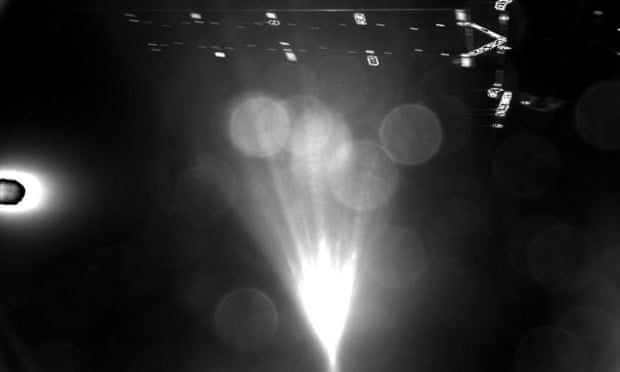 Philae’s shot of its mothership shortly after separation.Photograph: ESA/Handout/ESA/Handout/Corbis
Philae’s shot of its mothership shortly after separation.Photograph: ESA/Handout/ESA/Handout/CorbisFor the mission team, the seven-hour descent, during which Philae fell at walking speed towards the comet’s surface, was a nail-biting experience. The lander separated from its mothership at 0835 GMT with confirmation received on Earth at 0903. For the early part of the 20km descent, Philae was expected to be out of contact with Rosetta. Around 1100 GMT the mothership reacquired a signal from the lander, which duly unfurled its legs and began to take pictures. The first image taken just 50 seconds after separation revealed a look back at the mothership, one of its 14-metre-long solar arrays clearly visible, as Philae fell silently to its destination.
One hour from touchdown, Philae was on the right course. Ulamec of the DLR German space centre said everything looked “fantastic”. Telemetry from the lander showed that it was rotating, but not enough to cause problems.
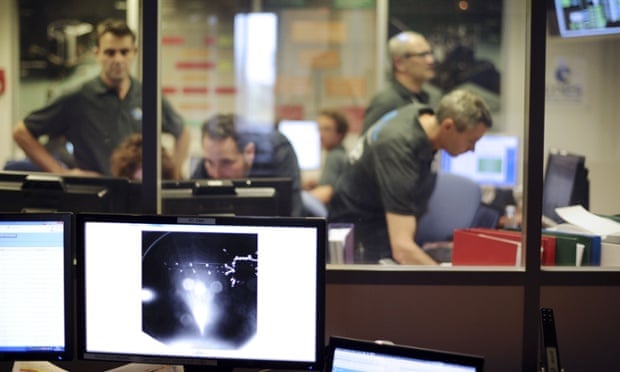 Scientists in Toulouse look at the first picture transmitted by Philae.Photograph: Remy Gabalda/AFP/Getty Images
Scientists in Toulouse look at the first picture transmitted by Philae.Photograph: Remy Gabalda/AFP/Getty ImagesFrom its orbit around the comet, the Rosetta probe will take more high-resolution images and gather information on the body’s density, temperature and chemical makeup. It will also capture dust and gas released in ever more violent jets from the comet’s nucleus as it nears the sun.
From its vantage point on the surface, the lander can drill down 20cm and collect samples of subsurface material for on-the-spot testing. On board Philae are 10 instruments, including one from the Open University named Ptolemy which will bake pieces of comet material and analyse the gases given off to build up a picture of the comet’s composition. Another instrument, the Comet Nucleus Sounding Experiment by Radiowave Transmission (Consert), will reveal the comet’s internal structure by passing radio waves through the icy body to Rosetta on the other side.
The Rosetta mission is planned to run until December 2015, but if enough fuel remains in the spacecraft’s tanks, mission controllers may extend its life by six months and give the mothership more high-risk tasks, such as flying through one of the gas and dust jets streaming from the comet. Philae has initial battery power to last 40 hours but will then switch to rechargeable ones replenished by sunlight.
The lander could continue working until March next year, when the electronics will become too warm to work properly. Even when Philae packs up, it may still cling on to the comet, perhaps for several 6.45-year-long laps around the sun, before enough material erodes from the comet’s surface for the lander to lose its grip.
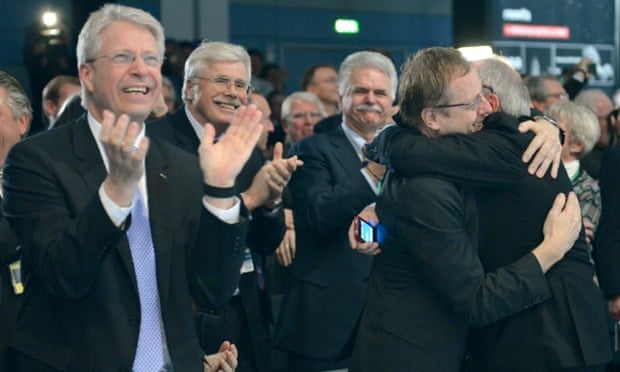 Celebrations at the European Space Agency’s mission control in Darmstadt.Photograph: Arne Dedert/Arne Dedert/DPA/Corbis
Celebrations at the European Space Agency’s mission control in Darmstadt.Photograph: Arne Dedert/Arne Dedert/DPA/Corbis